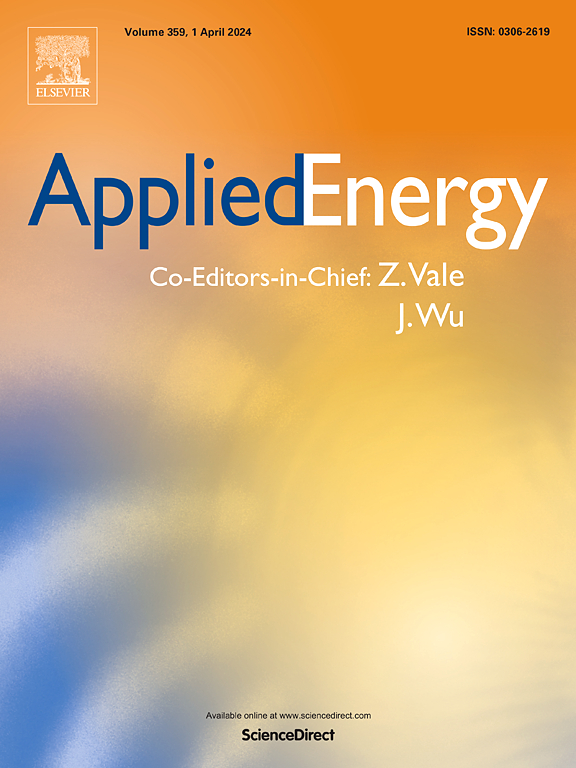综合评估数据中心中所有元素的灵活性资源:考虑计算、电和热的协同效益
IF 11
1区 工程技术
Q1 ENERGY & FUELS
引用次数: 0
摘要
探索数据中心内部资源的灵活性是实现节能减排和可持续发展的重要趋势。为了系统量化数据中心在计算、电力和热力方面的灵活性耦合机制和潜力,本文提出了一种集成容量规划和运行调度的数据中心多要素灵活性资源评估方法。它揭示了每种灵活性资源对数据中心的能源消耗、碳排放、经济成本、电力使用效率(PUE)、计算效率和其他集成性能指标的影响。在建立柔性资源协同运行模型的基础上,建立了全要素柔性资源的优化调度框架。结果表明,灵活性能够减少38.5%的碳排放,22.8%的能源消耗和21.6%的经济成本,同时显著提高PUE和计算效率。特别是,电力灵活性的利用显著减少了21.5%的碳排放,而计算灵活性和热灵活性的协调调节对降低能耗有显著影响(分别减少11.1%和13.1%)。此外,通过敏感性分析,分析了使用时间费率、工作负载状态和机架占用率等因素对灵活性资源利用率的影响,揭示了这些因素如何影响数据中心性能指标的优化。本文章由计算机程序翻译,如有差异,请以英文原文为准。
Comprehensive evaluation of all-element flexibility resources in data centers: considering synergistic benefits of computing, electricity, and heat
The exploration of internal resource flexibility in data centers is a significant trend for energy conservation, emission reduction, and sustainable development. To systematically quantify the coupling mechanisms and potential of flexibility in the computing, electricity, and heat side, this paper develops a multi-element flexibility resource evaluation method integrated capacity planning and operation scheduling for data centers. It reveals the impact of each flexibility resource on the data center's energy consumption, carbon emissions, economic costs, Power Usage Effectiveness (PUE), computing efficiency, and other integrated performance metrics. An optimization and scheduling framework for all-element flexibility resources is developed based on a collaborative operation model for flexibility resources established in this paper. The results show that the flexibility is able to reduce carbon emissions by 38.5 %, energy consumption by 22.8 %, and economic costs by 21.6 %, while significantly improving PUE and computing efficiency. In particular, the utilization of electricity flexibility notably reduces carbon emissions by 21.5 %, while the coordinated regulation of computing flexibility and heat flexibility has a significant effect on reducing energy consumption (by 11.1 % and 13.1 %, respectively). Furthermore, the impact of factors like time-of-use tariff, workload status, and rack occupancy rate on flexibility resource utilization is analyzed through sensitivity analysis, revealing how these factors influence the optimization of the data center's performance metrics.
求助全文
通过发布文献求助,成功后即可免费获取论文全文。
去求助
来源期刊

Applied Energy
工程技术-工程:化工
CiteScore
21.20
自引率
10.70%
发文量
1830
审稿时长
41 days
期刊介绍:
Applied Energy serves as a platform for sharing innovations, research, development, and demonstrations in energy conversion, conservation, and sustainable energy systems. The journal covers topics such as optimal energy resource use, environmental pollutant mitigation, and energy process analysis. It welcomes original papers, review articles, technical notes, and letters to the editor. Authors are encouraged to submit manuscripts that bridge the gap between research, development, and implementation. The journal addresses a wide spectrum of topics, including fossil and renewable energy technologies, energy economics, and environmental impacts. Applied Energy also explores modeling and forecasting, conservation strategies, and the social and economic implications of energy policies, including climate change mitigation. It is complemented by the open-access journal Advances in Applied Energy.
 求助内容:
求助内容: 应助结果提醒方式:
应助结果提醒方式:


